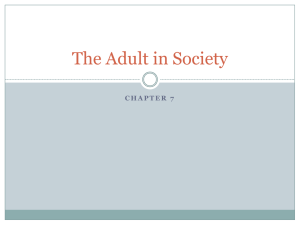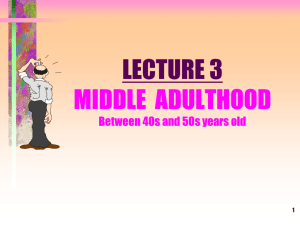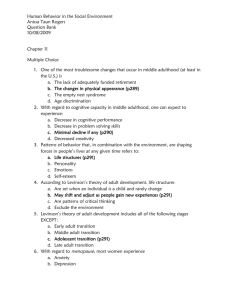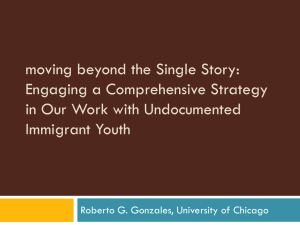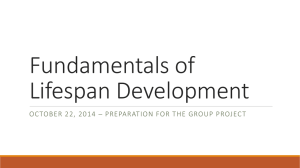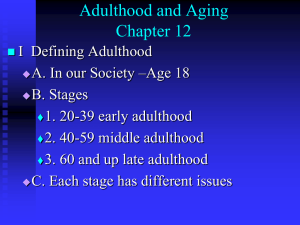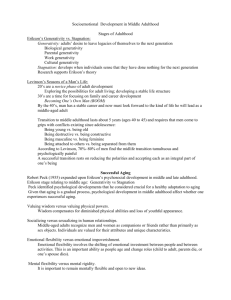Sociology Chapter 7_ sect
advertisement
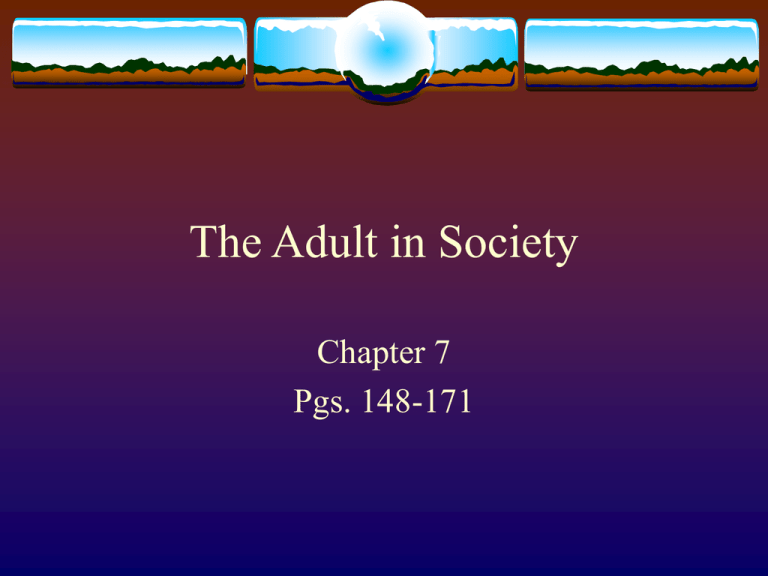
The Adult in Society Chapter 7 Pgs. 148-171 Early and Middle Adulthood What is Daniel Levinson’s theory of adult male development? What are the stages of adult female development? Psychologists Daniel Levinson and his colleagues at Yale University researched the lives of men in order to establish the stages of a man’s life. Adult Male Develpment Forty men between the ages of 35-45 were studied. They came from four broad occupational categories. 10 businessmen 10 hourly workers 10 biology professors 10 writers The interviews focused on such issues as Education Work Leisure Politics Friends Relationships with family Life Structure Levinson and his colleagues established each man’s life structure. They concluded that there were three basic eras of adulthood for men. Life Structure: the combination of statuses, roles, activities, goals, values, beliefs, and life circumstances that characterize an individual. Early adulthood, middle adulthood, late adulthood Each era began with a transitional period and was followed by alternating stable and transitional periods. Transitional and Stable Periods Transitional periods last from four to five years and stable periods last from six to eight years. Levinson places greatest stress on the first five periods of adulthood. Early adult transition Entering the adult world The age 30 transition The settling down period The midlife transition Early Adult Transition Occurs at ages 17-22 and is the bridge between adolescence and adulthood. The first task is leaving home both physically and psychologically. This occurs for most when they go to college or take a full time job and move out of their parent’s home. College students often received financial support Others may continue to live with their parents as a “boarder” while working full time to save money. Entering the Adult World Occurs at ages 23-27 and the individual takes on two contradictory tasks. 1. He is expected to explore a variety of relationships and career opportunities but must avoid strong commitments that will make it difficult for him to take advantage of new opportunities. 2. He is expected to become a responsible member of society and to form a stable life structure. This period is also characterized by the dream of adult accomplishment. Almost always phrased in terms of occupational goals Ex. Becoming a famous writer The Age 30 Transition Occurs at ages 28-32 and is a difficult period. Men look back at choices that have been made up to this point. Divorce is common in this stage. Levinson considered this period crucial to future development because it often is characterized by shifts in direction. Novice Phase Levinson referred to the first three periods of the early adulthood era as the Novice Phase. Novice Phase: the time when men prepare for entry into the adult world. The major task during this phase is to make a place for themselves in the adult world to construct a life structure that fits them and works in the adult world. The Settling Down Period Occurs at ages 33-39 and often referred to as “making it” in the adult world. Men must establish themselves in society usually by advancing in their chosen occupations. Individuals form true commitments to things such as work, family, leisure, friendship, community or whatever is most important in their lives. The Settling Down Period Near the end of this period, men come to realize how much they are relying on others as role models for guidance. They begin a conscious effort to establish their own identities. Levinson referred to this as Becoming One’s Own Man (B.O.O.M.) This involves separating oneself from a mentor. Mentor: is someone who fosters an individual’s development by believing in the person, sharing the person’s dreams, and helping the person achieve those dreams. Usually an older person in the world of work with more experience. Middle Adulthood Midlife Transition The first stage in middle adulthood and is the transition between early and middle adulthood. Occurs at ages 40-44. Similar to the age 30 transition in that it is about self examination. Individuals question their life structures. They also take stock of their likelihood of achieving the dreams from their 20’s. In most cases they come to realize that their earlier dreams are beyond fulfillment and begin to set new goals and dreams. Midlife Transition For 80% of the subjects in the study, the midlife transition was a period of moderate to severe crisis. Both internal and external conflict occur at this stage. Many men work through this crisis by becoming a mentor. For many who get through this stage it can be very rewarding and a creative experience. Adult Female Development Levinson suggested that his findings would be the same for women. He conducted another study to test his theory with 45 women. They came from three broad categories Homemakers College professors Corporate Executives He concluded that men and women go through the same stages but they differ in terms of of their social roles and identities. Some people argued that the differences he noted exist because the development is different for men and women. Irene Frieze and Esther Sales did work to support this argument. Phase 1: Leaving the Family Women’s entry involves leaving home, making a psychological break from parents, and developing a life plan. For many women the emphasis is less on career and more on marriage. Marriage is often considered the more important step. Marriage over career is one factor that distinguished female development from male development during adulthood. Phase II: Entering the Adult World The average age at first marriage in the U.S. has been rising since the 1960’s. Today it is 25.1 for women and 26.8 for men. Still many women get married and have children in their early 20’s. Motherhood and career are dual roles that can add strain on a woman. About 59 percent of new mothers who were in the work force before will return to work before their children reach one year of age. Phase II cont. Women’s job advancement possibilities become limited when they remain out of the labor force while their children are young. This break in employment is another factor that distinguishes female development from male development during adulthood. Phase III: Entering the Adult World Again Once their children reach school age, many mothers return to work. Women most of who are in their 30’s find themselves in a situation similar to that of men in their 20’s Fewer obligations at home mean they can actively pursue their career goals. Women develop a commitment to their jobs at about the same time men are beginning to question theirs. In conclusion American attitudes on marriage and gender continue to change. More and more Americans are simply not getting married Women are delaying parenting as well. The number of women in full time executive, administrative, and managerial positions – typical career positions is increasing. In nearly 1/3 of all working couples, the wife earns more than the husband does.
